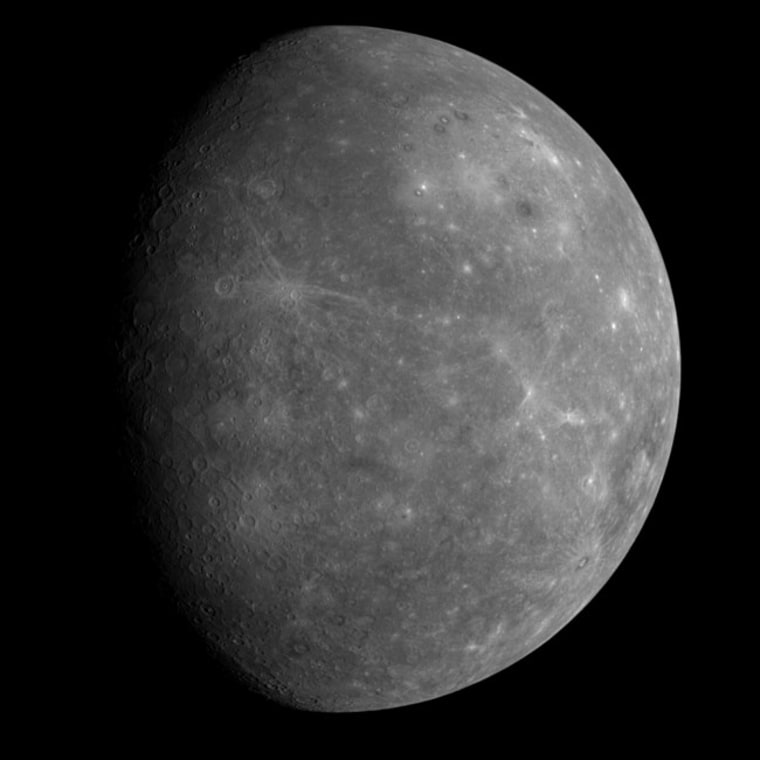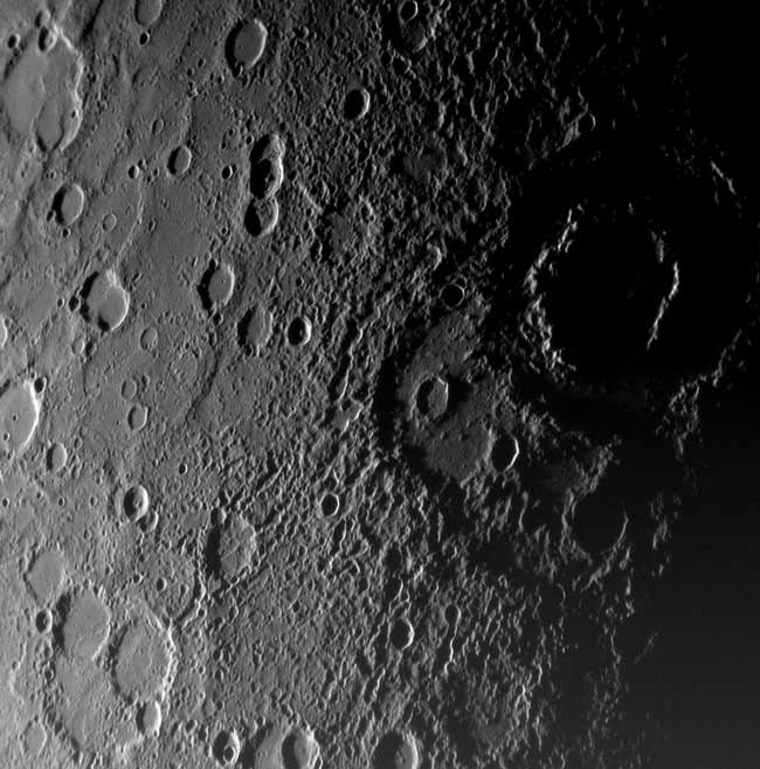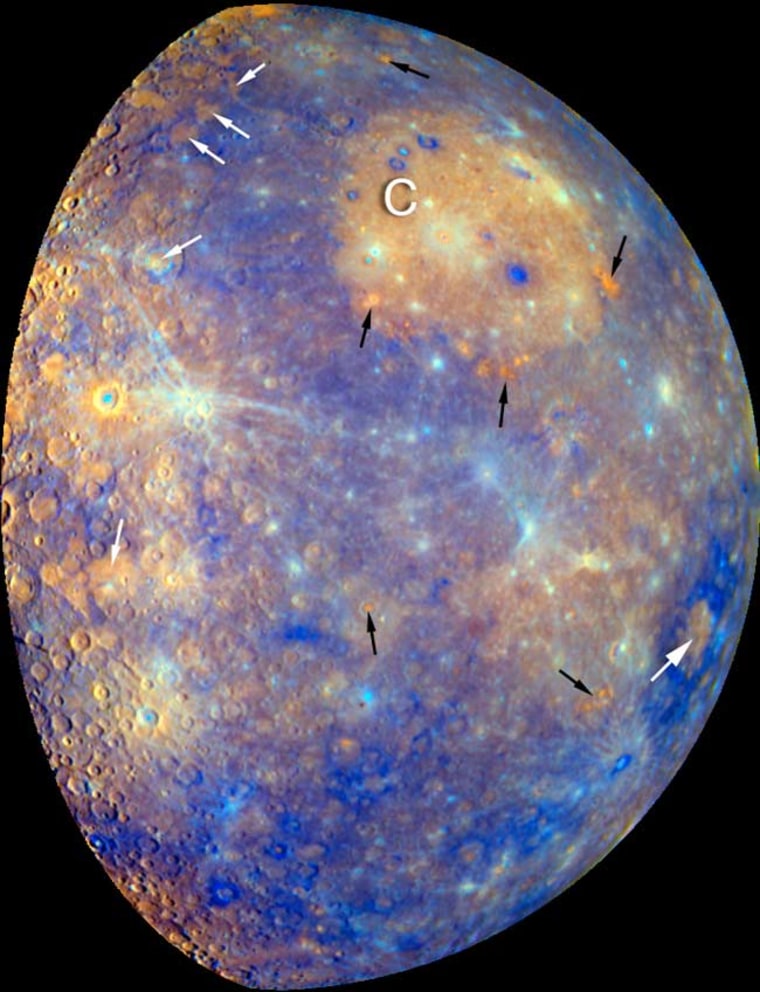A NASA spacecraft's first flyby of Mercury has yielded a wealth of information about the innermost planet, some of which confirms volcanism occurred there, settling a longstanding debate.
Information about such planetary mysteries as Mercury's magnetic field and geological history also has flooded in.
"We're really pleased," said Sean C. Solomon of the Carnegie Institution of Washington, principal investigator for the Messenger probe. "[The data] gives us a lot to chew on."
Messenger (short for MErcury Surface, Space ENvironment, GEochemistry and Ranging) made its debut flyby of Mercury on Jan. 14, passing about 124 miles (200 kilometers) over the planet's surface. The spacecraft's instruments took a closer look at the areas seen by the Mariner 10 mission in 1974 and 1975, which imaged about 45 percent of the planet's surface, as well as an additional 21 percent of the surface never before seen by a spacecraft.
In a collection of 11 papers detailed in Friday's issue of the journal Science, mission scientists presented the preliminary findings of the initial flyby.
Volcanism or impact melt?
Volcanism has long been thought to be a major force in shaping the rocky, terrestrial planets. Volcanoes still ravage Earth. On Mars, subdued volcanism may still be alive. Venus is riddled with old volcanoes.
Images of Mercury from the Mariner 10 mission showed areas of smooth plains covering parts of the planet's surface. Scientists speculated that these could be volcanic deposits, similar to the basaltic maria (seas) on the moon. But unlike the maria, these plains were lighter, not darker, than the surrounding landscape. At the time of the Mariner 10 mission, Apollo 16 astronauts had just discovered that similarly light plains on the moon were actually impact breccia, or rock that was smashed apart and then re-welded together again.
The resolution of the Mariner 10 images as well as the angle of sunlight illuminating the features prevented scientists from determining which geological mechanism had created the plains on Mercury.
"That created a stalemate for basically 30 years," until Messenger arrived on the scene, said science team member James Head of Brown University.
The angle of the sun's light on Mercury's features this time around yielded more detail and evidence pointing to volcanic activity. False-color images of the plains and presumed volcanic features showed that they had an orange tint and were "distinctly different from [their] surroundings," Head said.

Messenger images of the Caloris basin, the youngest-known impact basin on Mercury, showed smaller craters within the impact basin that had been filled in with material, "and if you had impact melt [as with the lunar breccia], that wouldn't happen," explained Johns Hopkins University's Scott Murchie, a co-investigator for the Mercury Dual Imaging System.
The small craters likely were the result of impacts in the basin long after it was formed. Later still, volcanic eruptions spewed lava across the basin, all but erasing the smaller craters. Head said this was "clear evidence that you're looking at lava flows."
Messenger also took images of what scientists think is a shield volcano, which are large with gently sloping sides, within the basin. Head said he knew volcanism was behind the smooth plains on Mercury as soon as the image of the volcano was beamed back to Earth: "This was really like a smoking gun."
The volcano is about 60 miles (95 kilometers) in diameter, bigger than the state of Delaware. "This is a big sucker," Head said.
Messenger also confirmed that the surface of Mercury is very low in iron, though the planet's high density implies that its core is very iron-rich. Head said this implies that Mercury formed slightly differently from the rest of the inner planets. The processes that formed the planet would have been the same, "it's just that the outcomes were so different," he told Space.com.
Planetary contractions
Scientists had hypothesized that Mercury underwent a significant contraction as its iron-rich core cooled, based on the results of the Mariner 10 mission. Images from that mission showed escarpments cut across much of the surface, indicating significant shortening of the planet's crust. The escarpments often deform other geological features.
"There are some craters that are just cut in half," Solomon said.
Messenger found more of these faults than Mariner 10 originally did, suggesting that the strain from the planet's contraction was at least one-third greater than scientists originally thought, one of the Science papers stated.
Essentially, as the hot, dense core cooled, some of the material would have solidified, sinking toward the center of the planet, forming an inner, solid core. When most solids cool, they also contract. In the case of Mercury, the planet's diameter was only decreased by about one-tenth of 1 percent, but in geologic terms, "it's a pretty big shrinkage," Solomon said.
When Messenger settles into orbit around Mercury in 2011 and gets a closer look at the escarpments, they may serve as "a record we can read" to determine when and how much contraction took place, and whether it happened continually and gradually or occasionally sped up, Solomon said.
Scientists will also be able to use variations in crater density across the surface to date the sequence of geological events. "The longer a surface sits out there, the more cratered" it becomes, Solomon explained, so more cratered surfaces should be older formations.
Above the surface
Messenger also used its flyby to investigate Mercury's magnetic field and magnetosphere, the region around a planet where the magnetic field influences other phenomena. Mercury is the only other planet in the inner solar system besides Earth that has a magnetic field.

During its flyby, Messenger took measurements of the magnetic field, and the results suggest that like Earth's field, Mercury's is largely dipolar (or like having a giant bar magnet stuck inside the planet).
But Mercury's magnetic field is much weaker than the one that surrounds our planet.
"Mercury's field is a smaller version of the Earth's," Solomon said.
Because the field is weak and Mercury is so close to the sun, the solar wind pushes the planet's magnetosphere very close to its surface on the side facing the sun, while on the side opposite the sun, the magnetosphere is very elongated.
In fact, "the solar wind gets very close to Mercury's surface some of the time," occasionally even hitting the surface, Solomon told Space.com.
When the solar wind hits Mercury's surface, it sputters particles off into the magnetosphere. Messenger detected these ionized atoms as it sailed through the magnetosphere; it found silicon, sodium, sulfur and even water ions surrounding the planet.
The impact of the solar wind also alters the chemistry of Mercury's surface, Solomon said, in a process called "space weathering." The chemical changes to weathered parts of the surface could help scientists determine which features are older, and which are fresh, newly exposed material.
Of course, this is just Messenger's first flyby, mission scientists noted. The second and third passes (to occur on Oct. 6 of this year and in September 2009) and the spacecraft's year-long orbital phase will likely yield even more information and shed further light on the history of the innermost planet.
